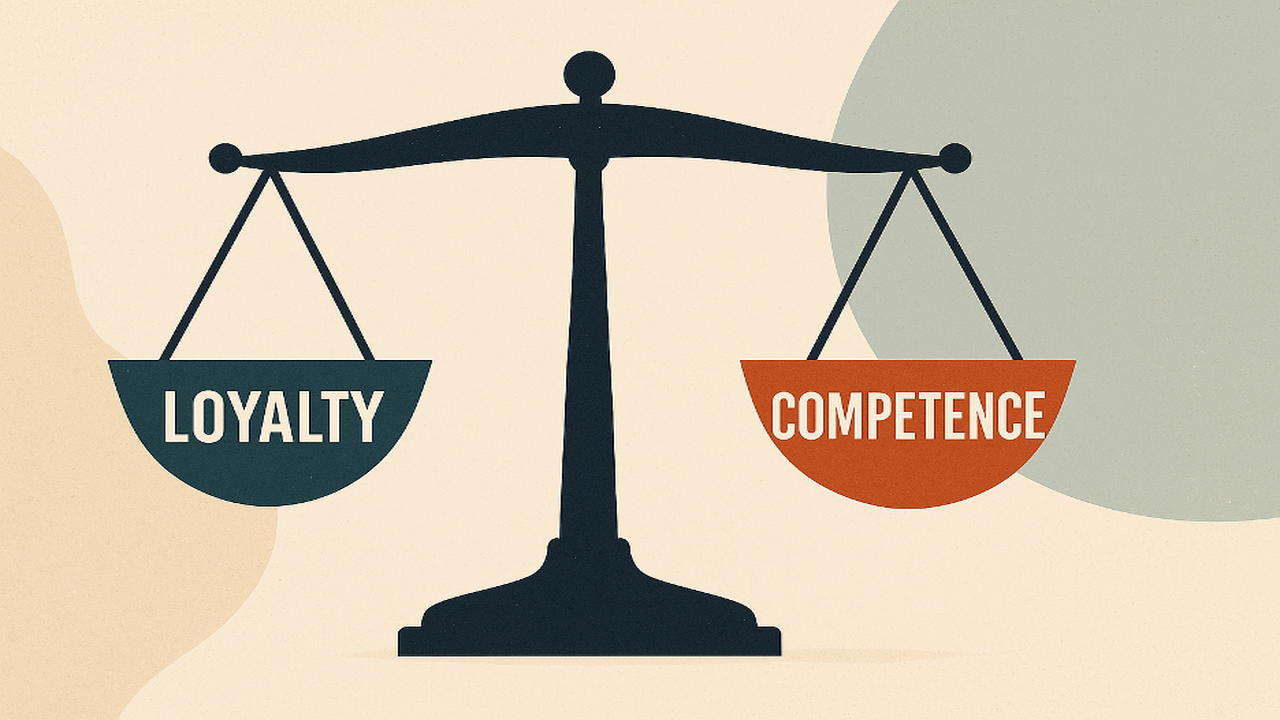Article
When Loyalty Becomes a Liability: Why Founders Must Confront Team Obsolescence

Every founder eventually faces a moment of reckoning. It doesn’t arrive with a clear announcement. It creeps in gradually, often disguised as small frustrations: projects slipping, team members complaining, or investors quietly losing confidence. And at the center of it all is a painful truth:
The people who carried you through the chaos of the early days, the ones who slept on office couches, pulled all-nighters, and took pay cuts to bet on your dream—can no longer keep up.
The company has grown. The stakes are higher. And the job has outgrown them.
This is one of the hardest truths in entrepreneurship, and one most founders struggle to face. Instead of acting, they convince themselves:
- “She’ll grow into the role.”
- “He’s been with me since day one—I can’t let him go.”
- “Loyalty matters more than resumes.”
But here’s the hard truth that separates founders who scale from those who stall: loyalty doesn’t scale. Competence does.
The Startup Version of the Peter Principle
The Peter Principle tells us that in large corporations, people rise to their level of incompetence. In startups, this principle plays out in hyper-speed.
What made someone a hero in a five-person company, improvisation, raw hustle, and the willingness to do anything becomes a liability in a 50- or 500-person company.
Think about the hacker who was indispensable in the garage. Brilliant at rapid problem-solving, he could patch servers at 3am and crank out features in a weekend. But leading a team of 50 engineers requires a totally different skill set: planning, delegation, recruiting, building processes. His improvisation becomes chaos. His genius turns into bottlenecks.
Or the co-founder who thrived on energy and vision. In the early days, charisma and instinct were enough. But scaling requires a discipline around metrics, process, and accountability. What once looked like bold leadership now looks like reckless improvisation.
Even the beloved “culture carrier”—the person who organized team offsites, boosted morale, and made the company feel like family—can become a roadblock. When decisions stack up and complexity explodes, loyalty and good vibes aren’t enough. What the company needs is a strategic operator, not just a glue person.
This is what I call team obsolescence: the brutal, recurring reality that many early employees get outgrown by the job.
The Head vs. Heart Conflict
Why do founders struggle so much with this? It’s not because they’re blind. It’s because they’re human.
The tension isn’t just intellectual—it’s emotional.
- Guilt and Indebtedness: Early employees bet on you before anyone else did. They turned down safer jobs, endured lower salaries, and staked their careers on your vision. Cutting them loose feels like betrayal. Psychologists call this the principle of reciprocity: the human drive to repay sacrifices. Founders feel they owe these people more than just a paycheck.
- Fear of Losing the Magic: Founders often worry that bringing in “outsiders” will ruin the scrappy, intimate culture that made the company special. This is a classic case of in-group bias. We trust the familiar, even when it’s no longer fit for purpose. Many founders cling to the idea that culture is fragile and must be protected from “corporate types.”
- Conflict Avoidance: Few people relish difficult conversations. Founders, especially those wired to inspire rather than confront, often procrastinate on hard personnel decisions. This is loss aversion at work: the immediate pain of conflict feels worse than the long-term risk of stagnation.
- Blind Loyalty Bias: Founders frequently overestimate an early employee’s ability to “grow into” a scaled role. This is the halo effect: past loyalty and past performance cast a glow that blinds you to current shortcomings.
This is the founder’s head-versus-heart struggle. Rationally, you know the company has outgrown someone. Emotionally, you can’t let go.
A Founder’s Story: When Friendship Meets Reality
One founder I coached built his company with a close college friend. This friend was the first engineer, working nights and weekends to bring the product alive. He coded nonstop, patched outages at all hours, and was the reason the company survived its early chaos.
By Series B, the company had 80 employees. Suddenly the role wasn’t about heroic coding; it was about systems, processes, and leading dozens of engineers.
The founder knew his friend was drowning. Deadlines slipped. Senior engineers were frustrated. Investors raised eyebrows. But he kept saying, “He’s been with me since the beginning. I owe him.”
Eventually, he faced reality. With coaching, he had the hard conversation: “You’re invaluable to this company, but the role has outgrown your strengths. Let’s find a place where you can thrive without being set up to fail.”
The friend transitioned into a specialist role where his brilliance could shine without the weight of leadership. The company brought in a seasoned VP of Engineering. Painful as it was, the decision saved both the company and the friendship.
This is the essence of true leadership: honoring loyalty without letting it sink the ship.
The High Price of Avoidance
The costs of avoidance aren’t abstract—they’re devastating.
- Execution Bottlenecks: An underqualified leader slows everything down. Projects drag, opportunities slip, and customers churn. It’s like trying to scale a skyscraper on a foundation built for a cottage.
- A-Players Walk: The best people won’t stay if forced to work under weak leaders. They leave, taking ambition and excellence with them. The company becomes a place where mediocrity thrives.
- Culture Corrodes: Protecting underperformers sends a loud signal: politics matter more than performance. Over time, resentment builds. High performers check out. Trust erodes.
- Investor Mistrust: Boards and investors notice quickly when execution falters. They start asking tough questions—not just about your team, but about your judgment as a founder.
- Founder Burnout: Perhaps the greatest cost: you, the founder, pick up the slack. Instead of scaling your vision, you spend nights fixing problems others should solve. Exhaustion sets in. Your energy, the one resource no one else can replace, gets depleted.
What feels like an act of loyalty today can quietly strangle the company’s future.
Another Case: The Culture Carrier
I once worked with a founder whose operations manager was beloved by the team. She organized payroll, ordered office supplies, and planned offsites. She was the glue.
But when the company hit 150 employees, the demands shifted. The job required scalable systems, compliance expertise, and strategic HR planning. She was still running things on spreadsheets and memory. People loved her, but they were increasingly frustrated with the chaos.
The founder feared that replacing her would “destroy the culture.” Eventually, he hired a Head of People. But instead of cutting her out, he redeployed her into an employee experience role. She continued to be the cultural heartbeat of the company while freeing leadership to professionalize operations.
The lesson: redeployment, when done thoughtfully, preserves loyalty without sacrificing competence.
What Great Founders Do Differently
The best founders I’ve studied don’t avoid this problem. They approach it with discipline and compassion.
1. They Diagnose Early They don’t wait until the crisis is obvious. They ask themselves, “If I were hiring for this role today, at this stage, would I choose this person?” If the answer is no, they don’t kick the can—they act.
2. They Separate Potential from Plateau Some people can grow. With coaching, training, and mentorship, they can rise to the next level. Others plateau quickly. Great founders don’t confuse the two. They invest in growth where it’s possible and cut losses where it’s not.
3. They Redeploy with Respect This isn’t about discarding people. The best founders move loyal employees into roles where their strengths shine—special projects, advisory positions, cultural leadership. Redeployment preserves respect and institutional knowledge while freeing the company to grow.
4. They Upgrade Before Crisis They don’t wait until the engine fails. They hire seasoned executives early, before execution falters. And they communicate clearly: every stage requires different skills. Honoring the past doesn’t mean guaranteeing the future.
Leadership with Compassion
The real test of a founder isn’t whether you can attract capital or inspire a team. It’s whether you can make the painful calls that protect the company’s future while respecting the people who got you started.
True leadership is not about cold detachment. It’s about balancing head and heart:
- Gratitude means honoring contributions, celebrating sacrifices, and rewarding loyalty.
- Governance means making clear-eyed decisions about whether someone can perform at the next level.
When founders confuse the two, they put sentiment ahead of survival. But when they balance both, they create companies that endure.
One founder I know addresses this directly with his team: “Every stage requires new skills. Some of us will grow into them.
Others will contribute in different ways. What matters is building a company that lasts.”
That’s leadership with compassion—telling the truth while honoring the past.
Why This Matters More Than Ever
The startup environment today is more unforgiving than ever. Capital is tighter. Investors are quicker to act. The margin for error is smaller.
In this climate, founders who delay tough calls are at greater risk than ever. Execution failures and cultural corrosion are spotted instantly by boards and competitors.
The founders who scale are those who balance loyalty with realism—who act before the cracks widen into chasms.
The Founder’s Real Test
It’s easy to celebrate early wins and bask in loyalty.
The real test is whether you can honor that loyalty without being trapped by it.
Because here’s the paradox: The only way to truly honor early sacrifices is to build a company that endures.
And that means making the call when loyalty becomes liability.
Call to Action
If you’re a founder facing this dilemma, don’t wait for the board to force your hand. Don’t wait for top talent to walk or investors to lose confidence.
Confront it now. Diagnose honestly. Redeploy with respect. Upgrade before crisis.
Be compassionate. Be decisive. Be clear-eyed.
Your team—and your company—will thank you later.
share this
Related Articles
Related Articles





